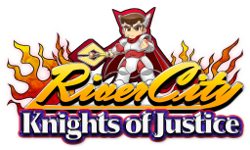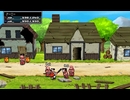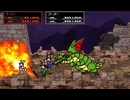|
|

|
PLATFORM
|
3DS
|
BATTLE SYSTEM
|

|
INTERACTION
|

|
ORIGINALITY
|

|
STORY
|

|
MUSIC & SOUND
|

|
VISUALS
|

|
CHALLENGE
|
Hard
|
LANGUAGE BARRIER
|
Moderate
|
COMPLETION TIME
|
Less than 20 Hours
|
|
OVERALL

|
+ Retro chic
+ Crazy fun action
- Very linear main quest line
- Plenty of plot teasing, very few explanations
- Cliffhanger!
|
Click here for scoring definitions
|
|
|
Have you ever heard of the game River City Ransom? Most of Japan has. Even my lovely wife, who generally has zero interest in gaming, recognizes the hero, Kunio-kun (Alex in the English translation). Kunio has starred in a ton of games, with RCR being the third out of many. Some of them are beat-em-ups, but others go in weird directions, like board games or dodgeball. In the summer of 2014, Arc System Works introduced a new style to Kunio in Nekketsu Mahou Monogatari.
The original game was in many ways an action game with RPG elements long before it was cool to do so, and NMM takes that even farther by covering the classic combat with a thin veneer of Dragon Quest. There are knights, there are goblins, there are swords and magic and giant dragons. There's HP, MP, and special skills. What there is not is any sense of statistical advancement beyond equipment. Kunio, or Kooney in this incarnation, cannot improve his base power on his own. Different weapons, gloves, and boots all give bonuses to attack and skill power, for example. Rings boost just about any stat, but they're expensive. All special attacks come from scrolls purchased at stores. This game could have been a great opportunity to use gated leveling mechanics in order to keep the difficulty more regular as Kooney progresses, but as it is now the difficulty's not impossible, just tricky.
Nekketsu uses the Chinese symbols for "burning blood," but translates as "passionate." With a name like that, combat should (and does) take a big role. A major part of this is the grab and smash mechanic. Kooney can pick up the rocks and pots lying around the battlefield, weapons knocked from enemies' hands, or even the enemies themselves, in order to lay the smack down. The A and B buttons see plenty of use, with A being for punching, grabbing, or walloping in battle, while B is for kicking or throwing held items. The Y button makes Kooney jump, and the X is used to activate consumable items or spells from magic staves. Special attacks usually require some combination of buttons to use, and some weapons have attributes that allow for new strategies, like the Shinobi Sword's boomerang throw trick.
 Bat to the face!
Bat to the face!
|
|
Considering how important equipment management can be mid-battle, it's surprising that Arc System Works couldn't come up with a better interface for it. Some of this is certainly dictated by the constraints of copying the River City Ransom model so closely, but all the same the systems take some getting used to. The player can place up to nine items in the immediate inventory, but the only way to toggle between them during battle is the right shoulder button, without pausing, and only in one direction along the equipment list. The left shoulder button switches the player through different party members, which just adds one more unnecessary complication to the mix. Again, it's not much of an issue once the player gets used to it, but since it's hard to get through the latter parts of the game without some shuffling between weapons, items, and bare hands for grabbing, it's certain to be an annoyance.
 Crunchy and good with ketchup!
Crunchy and good with ketchup!
|
|
The story is generically fantastical, in keeping with the rest of the presentation. Years ago, a strange darkness engulfed the holy tower at the heart of the world, and monsters appeared. One of the ten kingdoms turned rogue, allying with the darkness in order to conquer its neighbors. Into this chaotic mess arrives Kooney Volford, a swordsman with no past and a strange willingness to take any random quest villagers might give him. While the main quest follows a nearly straight path through three neighboring kingdoms, numerous NPCs are willing to let Kooney solve their problems for them, be it slaying a dragon or procuring lunch. These side quests will take the player back and forth across the land, but the cash they provide is essential for equipping Kooney with everything he needs to survive his showdown with the sinister sorcerer Ya Marda.
 The Wide World of Pixels
The Wide World of Pixels
|
|
Unfortunately, the game ends on the most obvious cliffhanger possible, with no real answer to the many questions raised. What happened to the goddess in the holy tower? From whence came the darkness? What was the deal with some of the recurring characters? Who is Kooney Volford, really? The game certainly implies that there's a lot going on behind the scenes, but so far that's about all it does. It's an incredible plot tease, all for selling the next installment.
Musically and visually, this game is intentionally retro, being one long, extended tribute to River City Ransom. While the graphics and soundtrack are definitely of higher quality than any game of the NES or SNES generations could hope to be, that is still the era the developers were aiming for. The results are awkward at times, with character and monster sprites sometimes looking crude and blocky against better rendered backdrops, but then again this is precisely the effect that was intended here. One last instance of retro design can be found throughout the game, specifically in the text box. NMM does not use any kanji at all, only hiragana and katakana. While this technically makes it easier for beginners in Japanese to look up words in the dictionary, in practice it makes things more difficult for those who have learned to use kanji as a visual shorthand for quick understanding. Again, there is absolutely no need to have it this way, except to emulate the original NES experience as closely as possible.
Nekketsu Mahou Monogatari is an interesting experiment in nostalgia that would have done better to pay attention to advances made available by its hardware. While there is a place for retro chic, the developers failed to realize that some retro elements were abandoned with good reason. The incomplete nature of the game's plot doesn't earn it any extra points either. Still, it was an interesting experience, and I arrived at the end of it all really hoping that, against all my intuition, the game would in fact keep going. Alas, it was not meant to be so, and I shall have to wait for the next installment to appear on the 3DS shop sometime in the future.
Review Archives
|









